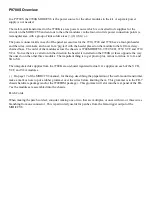
18 / 30
23906-000 en/2022-11
1
electronic GmbH & Co. KG • Heinrichstraße 3-4 • 12207 Berlin • Deutschland • info@bandelin.com
4.3
Further information
4.3.1
Degassing
Degassing the sonication
fl
uid increases the ultrasound e
ff
ect.
Freshly-
fi
lled contact liquid or liquid that has remained in the oscillating tank for a long
period of time must be degassed prior to use. Gases released in the liquid (e.g. oxygen)
are reduced through degassing, thus signi
fi
cantly improving the ultrasound e
ff
ect.
The cavitation noise changes during degassing, loud degassing noises fade away at
the end of the degassing process and the ultrasonic bath appears to work more quietly.
A lower noise level does not mean, however, a reduction in ultrasonic power. Rather, it
signi
fi
es the end of the degassing process and an improvement in the ultrasound e
ff
ect.
4.3.2
Disposal of sonication liquids
The working solution is disposed of pursuant to the speci
fi
cations of the product
lea
fl
et and the label. All aqueous agents made by DR. H. STAMM GmbH are prepared
pursuant to the regulations of the German Washing and Cleansing Agents Act, are
biodegradable, and may be added to sewerage as working solutions. Strongly acidic
and strongly alkaline liquids are to be previously neutralised pursuant to technical
data sheet speci
fi
cations. The manufacturer speci
fi
cations for the corresponding
preparations are to be observed.
Depending on the type of contamination involved, water-polluting substances such as
oils, heavy metal compounds, etc. may be introduced to the working solution during
cleaning. If the limit values are exceeded, the working solution must be reconditioned
(removal of contaminants) or be disposed of as toxic waste.
Disinfection and cleaning agents that become contaminated when used are considered
"waste material" pursuant to the Waste Act (AbfG) and may not be taken back by the
manufacturer.
In every case, the statutory provisions and regulations of municipal wastewater plants
are to be adhered to. Information is provided by municipal wastewater plants as well as
by environmental agencies.













































